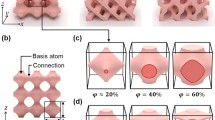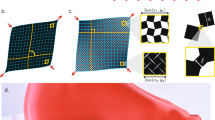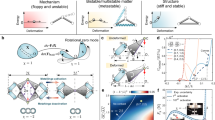Abstract
Negative extensibility metamaterials are able to contract against the line of increasing external tension. A bistable unit cell exhibits several nonlinear mechanical behaviors including the negative extensibility response. Here, an exact form of the total mechanical potential is used based on engineering strain measure. The mechanical response is a function of the system parameters that specify unit cell dimensions and member stiffnesses. A phase diagram is calculated, which maps the response to regions in the diagram using the system parameters as the coordinate axes. Boundary lines pinpoint the onset of a particular mechanical response. Contour lines allow various material properties to be fine-tuned. Analogous to thermodynamic phase diagrams, there exist singular “triple points” which simultaneously satisfy conditions for three response types. The discussion ends with a brief statement about how thermodynamic phase diagrams differ from the phase diagram in this paper.












Similar content being viewed by others
References
Klatt T, Haberman MR (2013) A nonlinear negative stiffness metamaterial unit cell and small-on-large multiscale material model. J Appl Phys 114(3):033503
Wu Y, Lai Y, Zhang ZQ (2011) Elastic metamaterials with simultaneously negative effective shear modulus and mass density. Phys Rev Lett 107(10):105506
Qu J, Kadic M, Wegener M (2017) Poroelastic metamaterials with negative effective static compressibility. Appl Phys Lett 110(17):171901
Babaee S, Shim J, Weaver JC, Chen ER, Patel N, Bertoldi K (2013) 3D Soft metamaterials with negative Poisson’s ratio. Adv Mater 25(36):5044
Bückmann T, Stenger N, Kadic M, Kaschke J, Frölich A, Kennerknecht T, Eberl C, Thiel M, Wegener M (2012) Tailored 3D mechanical metamaterials made by dip-in direct-laser-writing optical lithography. Adv Mater 24(20):2710
Bückmann T, Thiel M, Kadic M, Schittny R, Wegener M (2014) An elasto-mechanical unfeelability cloak made of pentamode metamaterials. Nat Commun 5:4130
Wang K, Zhao Y, Chang YH, Qian Z, Zhang C, Wang B, Vannan MA, Wang MJ (2016) Controlling the mechanical behavior of dual-material 3D printed meta-materials for patient-specific tissue-mimicking phantoms. Mater Des 90:704
Coulais C, Sounas D, Alù A (2017) Static non-reciprocity in mechanical metamaterials. Nature 542:461
Lakes R (2001) Extreme damping in compliant composites with a negative-stiffness phase. Philos Mag Lett 81(2):95
Lakes R, Rosakis P, Ruina A (1993) Microbuckling instability in elastomeric cellular solids. J Mater Sci 28(17):4667
Moore B, Jaglinski T, Stone D, Lakes R (2006) Negative incremental bulk modulus in foams. Philos Mag Lett 86(10):651
Nicolaou ZG, Motter AE (2012) Mechanical metamaterials with negative compressibility transitions. Nat Mater 11(7):608
Jaglinski T, Kochmann D, Stone D, Lakes R (2007) Composite materials with viscoelastic stiffness greater than diamond. Science 315(5812):620
Lakes R, Wojciechowski K (2008) Negative compressibility, negative Poisson’s ratio, and stability. Physica Status Solidi (b) 245(3):545
Dyskin AV, Pasternak E (2012) Elastic composite with negative stiffness inclusions in antiplane strain. Int J Eng Sci 58:45
Silverberg JL, Evans AA, McLeod L, Hayward RC, Hull T, Santangelo CD, Cohen I (2014) Using origami design principles to fold reprogrammable mechanical metamaterials. Science 345(6197):647
Boatti E, Vasios N, Bertoldi K (2017) Origami metamaterials for tunable thermal expansion. Adv Mater 29:1700360
Chen Y, Li T, Scarpa F, Wang L (2017) Lattice metamaterials with mechanically Tunable Poisson’s ratio for vibration control. Phys Rev Appl 7(2):024012
Chen M, Karpov E (2014) Bistability and thermal coupling in elastic metamaterials with negative compressibility. Phys Rev E 90(3):033201
Harne RL, Wu Z, Wang KW (2016) Designing and harnessing the metastable states of a modular Metastructure for programmable mechanical properties adaptation. J Mech Des 138(2):021402
Che K, Yuan C, Wu J, Qi HJ, Meaud J (2017) Three-dimensional-printed multistable mechanical metamaterials with a deterministic deformation sequence. J Appl Mech 84(1):011004
Liu A, Zhu W, Tsai D, Zheludev NI (2012) Micromachined tunable metamaterials: a review. J Opt 14(11):114009
Rafsanjani A, Akbarzadeh A, Pasini D (2015) Snapping mechanical metamaterials under tension. Adv Mater 27(39):5931
Karpov EG, Danso LA, Klein JT (2017) Negative extensibility metamaterials: occurrence and design-space topology. Phys Rev E 96(2):023002
Otsuka K, Wayman CM (1999) Shape memory materials. Cambridge University Press, Cambridge
Dong J, Cai C, Okeil AM (2010) Overview of potential and existing applications of shape memory alloys in bridges. J Bridge Eng 16(2):305
Zeeman EC (1977) Catastrophe theory: selected papers, 1972–1977. Addison-Wesley, Boston
Saunders PT (1980) An introduction to catastrophe theory. Cambridge University Press, Cambridge
Gilmore R (1993) Catastrophe theory for scientists and engineers. Courier Corporation, North Chelmsford
Liu WK, Karpov E, Zhang S, Park H (2004) An introduction to computational nanomechanics and materials. Comput Methods Appl Mech Eng 193(17):1529
Kan Q, Yu C, Kang G, Li J, Yan W (2016) Experimental observations on rate-dependent cyclic deformation of super-elastic NiTi shape memory alloy. Mech Mater 97:48
Ortın J, Delaey L (2002) Hysteresis in shape-memory alloys. Int J Non-Linear Mech 37(8):1275
Dolce M, Cardone D (2001) Mechanical behaviour of shape memory alloys for seismic applications 1. Martensite and austenite NiTi bars subjected to torsion. Int J Mech Sci 43(11):2631
Saadat S, Salichs J, Noori M, Hou Z, Davoodi H, Bar-On I, Suzuki Y, Masuda A (2002) An overview of vibration and seismic applications of NiTi shape memory alloy. Smart Mater Struct 11(2):218
Liu WK, Karpov EG, Park HS (2009) Nano mechanics and materials: theory, multiscale methods and applications. Wiley, Hoboken
Lukas HL, Fries SG, Sundman B (2007) Computational thermodynamics: the Calphad method. Cambridge University Press, Cambridge
Author information
Authors and Affiliations
Corresponding author
Rights and permissions
About this article
Cite this article
Klein, J.T., Karpov, E.G. Negative extensibility metamaterials: phase diagram calculation. Comput Mech 62, 669–683 (2018). https://doi.org/10.1007/s00466-017-1520-2
Received:
Accepted:
Published:
Issue Date:
DOI: https://doi.org/10.1007/s00466-017-1520-2




